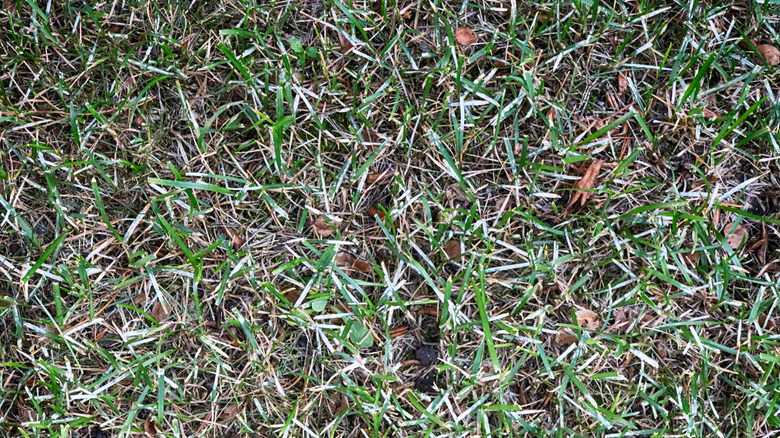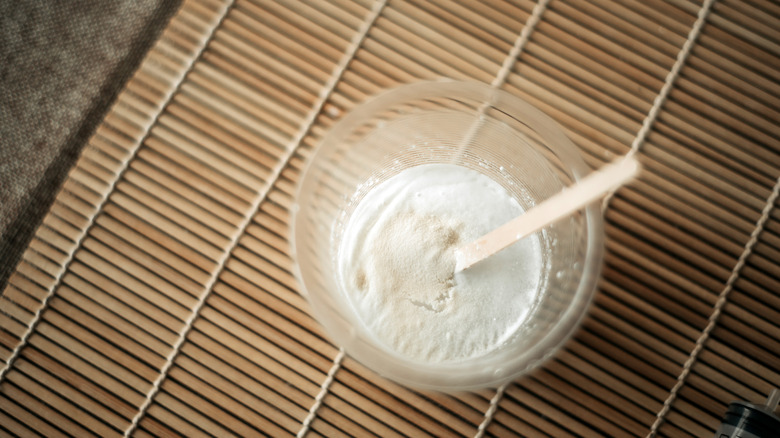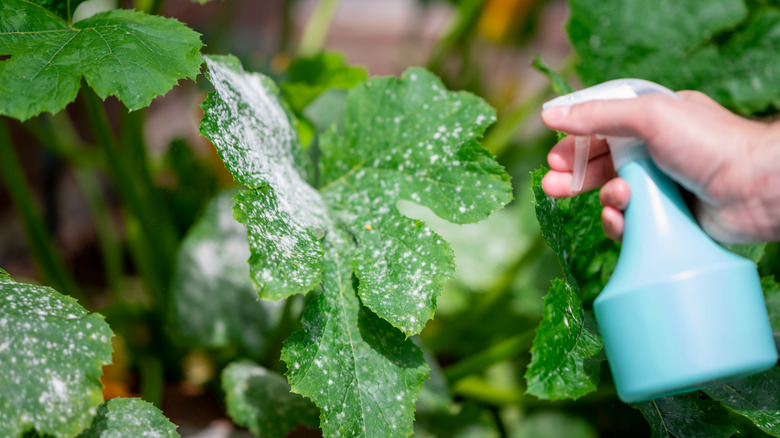Here's How You Could Reduce Powdery Mildew In Your Grass Using One Common Pantry Ingredient
If you're battling powdery mildew on your lawn, a simple yet effective solution lies in your kitchen cabinet: baking soda. Some gardeners swear this household staple doubles as a powerful agent against powdery mildew, a common fungal problem identifiable by its distinct white and gray, powdery growth. The idea is that baking soda shifts the pH balance on plant surfaces, creating conditions unfavorable for fungal growth. This is significant because powdery mildew can't survive in heavily alkaline environments. That said, the efficiency of baking soda may be anecdotal, not factual, since scientific evidence shows mixed results. According to a 2009 article by Linda Chalker-Scott, Ph.D., at Washington State University, baking soda doesn't completely eliminate fungi. However, low levels of baking soda did successfully disrupt growth and germination rates for some powdery mildew species when used in various greenhouse plants. On the contrary, she also notes that baking soda has lower success rates in field research.
Despite the mixed results, this approach to getting rid of powdery mildew is certainly worth a try, and baking soda is particularly appealing for its minimal environmental impact. Unlike chemical fungicides, which can be harsh, baking soda could be a safer alternative. Also, fungus is more than just an aesthetic issue; if not controlled, its spores can travel through the air and spread rapidly under favorable conditions. But it's also important to be vigilant when using baking soda since information about the long-term potential side effects is limited.
Effective use of baking soda spray against powdery mildew
As mentioned, much of the evidence that baking soda works is anecdotal, not factual. So, you must use it cautiously. Colorado State University advises creating a baking soda spray consisting of a gallon of water and a tablespoon of baking soda. You can also add a couple of tablespoons of horticultural oil to act as a surfactant, reducing the surface tension of a liquid. The 2009 article by Linda Chalker-Scott, Ph.D., agrees with the idea of including horticultural oil in the mixture. She also highlights that a mixture of diluted sodium bicarbonate and horticultural oil might provide some relief for less severe powdery mildew infections. She even goes on to warn against solely applying baking soda, stating that it isn't a reliable remedy and could even be harmful to plants if used in excess.
When applying the spray, it might be best to test on a small patch first to be sure the mixture won't cause even more damage. You can then apply the mixture to the affected areas thoroughly, including the often-overlooked undersides of leaves and stems, where mildew can hide and proliferate. You might need to reapply the mixture for effective results. However, exercise caution with the frequency and quantity of application. Mixing in too much baking soda could potentially make the problem worse, leading to plant death. This is especially true if the soil becomes too alkaline.
Other important considerations in preventing powdery mildew
While using baking soda can be a good start, there are other effective lawn maintenance strategies to prevent powdery mildew from taking hold of your turf. First, it's always best to select shade-tolerant grasses. Opt for fine or red fescue. These varieties are particularly resilient against mildew, especially in less sunny areas. But it's not just about the right grass type. Your lawn care routine is crucial to making your lawn healthier, and a stronger lawn is more resistant to diseases. You might have to adjust your watering schedule to ensure the moisture level in your lawn is well-balanced, especially in shady areas. Overwatering can create damp conditions that mildew loves, so aim for deep, infrequent watering. A weekly watering of about an inch is ideal, but even less in shady spots.
Mowing height is another key factor. Keep your turf about 3 inches high. This height is not just for looks; it promotes deeper rooting. Fertilization is also important. Use the right type and amount of fertilizer for your grass. Over-fertilizing, particularly with high nitrogen levels, can lead to lush, tender growth that's more susceptible to mildew. Strike a balance to keep your lawn robust but not overly rich. Lastly, try to prune when needed. This will involve cutting back overgrown branches from nearby trees and shrubs to let in more sunlight and air. Aim to thin out the branches instead of just cutting them shorter.


